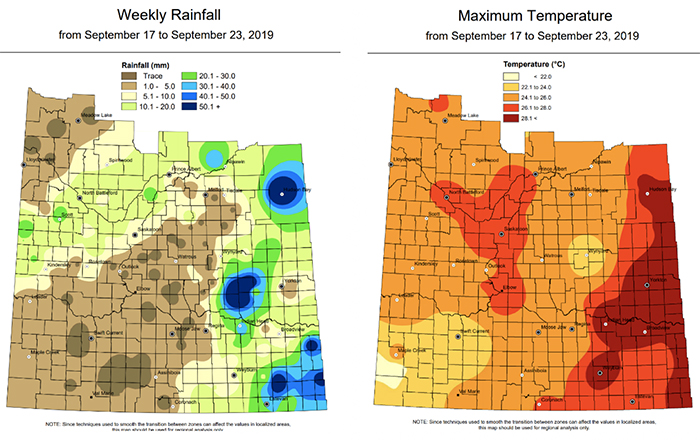October 1, 2019
Rains are slowing the combines and eroding the quality of the pulse crops still out in the fields.

Before it got mired in rainy weather, Canada’s pulse harvest was off to a decent start. Quinton Stewart, president of the Canadian Special Crops Association, estimates that about 60% of the peas and lentils had come off the fields ahead of the rains. Since then, however, harvest has been stop-and-go, creating a challenge for farmers as rains whittle away at the quality of what is still left out in the fields.
The lentil crop has been especially impacted, with high incidences of sprouting, bleaching and wrinkling. As a result, a broader grade distribution is anticipated, with No. 1 green lentil supplies likely tighter than usual. Although carry-in on lentils is abundant heading into 2019/20, most of the higher-grade old crop lentils are of the red rather than the green variety.
In terms of yields, official reports project they will be above average for lentils this year. Stewart, however, is skeptical. Although some areas did reap good yields, he believes subpar yields on green lentils in the southern parts of the growing area, especially southern Alberta, will knock down the average to normal levels.
As for peas, the crop was also impacted by the rains, with sprouting and wrinkling reported, although to a lesser extent. On green peas, Stewart reports that more than half the crop got caught out in the rain.
“We are going to have significant tonnage of green peas with 30 to 40% bleaching,” he says.
The lentil and pea harvests should wrap up in the next two weeks. In Stewart’s estimation, the lentils still out in the field are likely to end up in the feed or pet food market. As for the yellow peas that remain to be harvested, he expects they will be mostly low-grade product.
The chickpea harvest is not as far along, and Stewart has not seen new crop samples yet. But here again, he expects downgraded quality due to the wet weather. The dry bean harvest is even less advanced.
With more rain and even snow in the short-term forecast, Stewart says growers are presently focused on salvaging their wheat and durum crops, which can still hold their grade and earn a premium, rather than on harvesting their pulses.
“It’s been stop and go with the harvest and that makes for a lot of challenges,” says Stewart. “There will be a lot of tough and high-moisture product going into the processing pipeline this year.”
Buyers, meanwhile, remain mostly on the sidelines. Because of the uncertainty around trade with India and China, few are making forward purchases. The exception, says Stewart, is on green lentils and green peas, where some buyers are interested in securing ownership of the higher-end grades. For other pulses, including yellow peas and red lentils, buyers are in no rush to make commitments, given the availability of abundant global supplies and the uncertain trade environment that currently exists.
To provide readers with a sense of crop conditions on the ground, we offer the following summaries of the pulse-related information contained in the latest provincial crop reports.

Source: StatCan website accessed September 27.
For the seven-day period ending September 23rd, conditions remained generally cool and damp. The pea harvest advanced to 78% complete, while harvest progress on lentils and chickpeas was 95%. On peas, average yields varied from a low of 29 bushels/acre in the south to a high of 46 bushels/acre in Peace. The following grade distribution was reported:
Because of widespread rains, only two days were suitable for harvest during the seven-day period ending September 23rd. The pea harvest is complete, with 112,574 acres harvested. In northwest Manitoba, yields ranged from 40 to 80 bushels/acre. The dry bean harvest is at 18%, behind the 62% average pace for the date. Manitoba farmers seeded 155,752 acres to beans this year, the most the province has dedicated to beans in a decade. In central Manitoba, the bean harvest is further along, with 40% of the crop combined. Bean yields there have averaged 1500 to 1800 lbs/acre, but rain damage is a concern for the crop that remains out in the fields.
For the seven-day period ending September 23rd, rains gave way to warm, dry weather, which allowed crops to dry down and growers to make harvest progress. In terms of pulses, harvest advanced to 89% complete for peas, 88% for lentils and 37% for chickpeas. Topsoil moisture levels rated 6% short, 79% adequate and 15% surplus.

Source: Saskatchewan Ministry of Agriculture, Crop Report for September 17 – 23.

Canada / Quinton Stewart / Canadian Special Crops Association / Manitoba / Alberta / Saskatchewan
Disclaimer: The opinions or views expressed in this publication are those of the authors or quoted persons. They do not purport to reflect the opinions or views of the Global Pulse Confederation or its members.